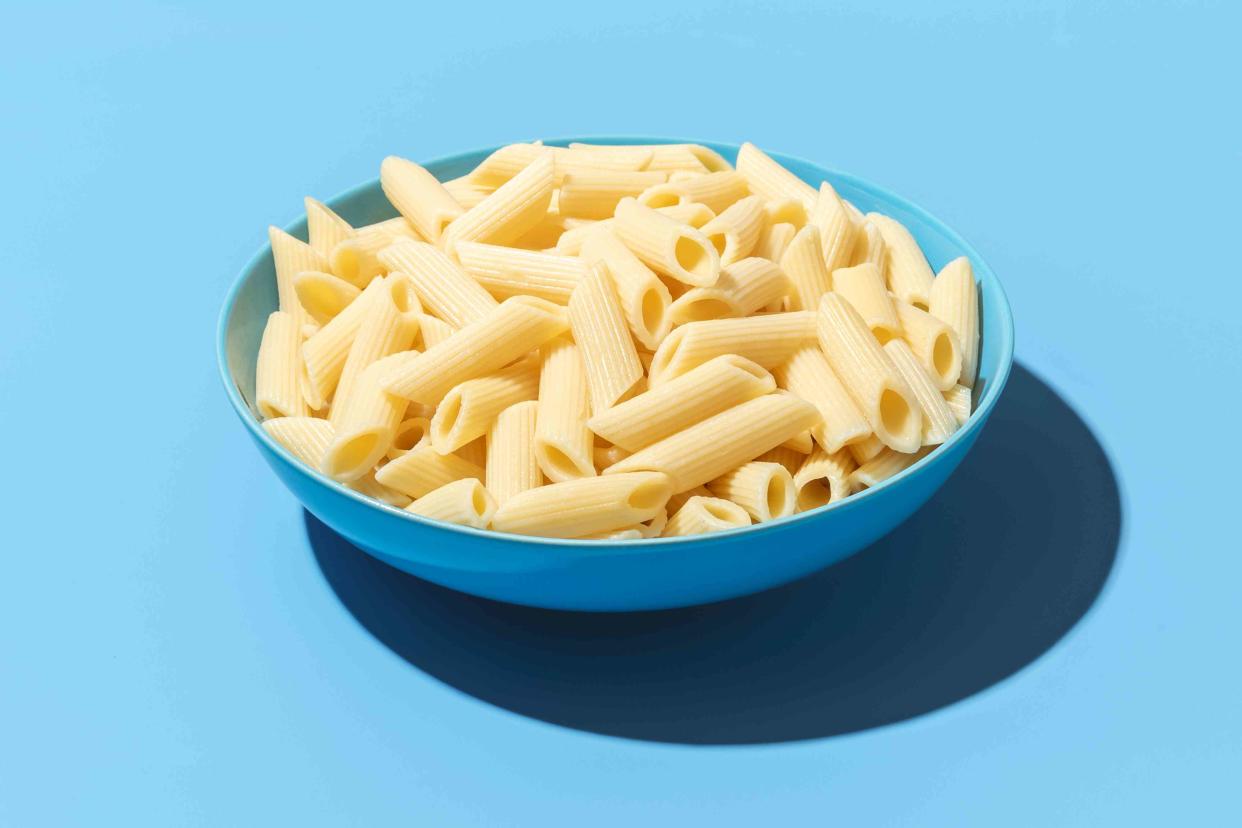Is Pasta Healthy? Everything to Know About This Super Cravable Food
Here's a breakdown of the nutrition facts—and how to incorporate this food into a balanced diet.

A big dish of pasta can be a salivating sight. For all the lovers of pappardelle, spaghetti, rigatoni and countless other forms of pasta, you may be tempted to eat pasta for every meal. (And trust us, we are too.) But before you swap out your entire pantry supply with boxes of pasta, it's worth asking: Is pasta healthy? Well, here's a breakdown of the nutritional facts and benefits.
According to nutritionvalue.org, 1 cup of cooked pasta contains the following macronutrient profile: 40-45 grams of carbohydrates; 8-10 grams of protein, 1-2 grams of total fat, and 3-4 grams of fiber. The most prevalent micronutrients in pasta are thiamin, folate, riboflavin and niacin, while minerals include selenium, copper, sodium and iron.
Like many other foods, pasta can be part of a balanced diet when consumed in moderation, says Martha Theran, MS, RD/RDN, registered dietician nutritionist and educator at Pritikin Longevity Center. “Pasta is packed with a host of health benefits," she says. "Rich in carbohydrates, the preferred source of energy for the human body. Pasta provides a sustained energy release, promoting satiety and aiding weight management. In addition, it's a valuable source of essential nutrients like iron and B-vitamins, which are essential for maintaining a healthy metabolism.”
Keep reading for more on the health benefits and good-to-know facts about pasta.
Related: 35 Perfect Pasta Recipes You'll Want to Make for Dinner Tonight (and Every Night)
Top Health Benefits of Pasta
According to Theran, pasta supports digestive health, weight management, and reduces the risk of chronic diseases like heart disease and type 2 diabetes. Whole grain pasta, in particular, delivers more fiber, protein, fat, vitamins, and minerals, when compared to refined pasta. “One of the key components that make whole-grain pasta an excellent choice for weight management is its high fiber content,” Theran says. “Fiber plays a crucial role in promoting satiety, keeping you fuller for longer periods and reducing overall calorie intake."
Healthy ways to enjoy pasta as part of a balanced diet
Pasta can be a great vehicle for incorporating nutrient-packed ingredients, like colorful vegetables, lean proteins, and healthy fats, enhancing its nutritional profile. “Add vegetables, lean proteins (like chicken, fish, or beans), and healthy fats (like olive oil or nuts) to your pasta dishes” Theran recommends. “Use tomato-based sauces instead of creamy ones to reduce saturated fat and extra calorie intake and use whole grain pasta instead of refined pasta for added fiber and nutrients.”
Brian Seaman, chef de partie at InterContinental Dominica Cabrits Resort & Spa also suggests looking for pasta infused with beet or spinach puree, for any pasta lovers that want to add nutritional value. As a local Dominican, Seaman specifically recommends pasta made with cassava flour—a native root—as a healthy alternative to wheat flour.
Is it healthy to eat pasta every day?
Eating pasta every day can be part of a healthy diet if it's balanced with other nutritious foods and portion sizes are controlled. “The key lies in opting for whole grain varieties, addition of other macronutrients, like protein and healthy fats, and being mindful of portion control,” Theran says. “Keep in mind that variety in your diet is important to ensure you're getting a wide range of nutrients.”
Pasta alternatives for those with gluten sensitivity or intolerance
Pasta is typically made from wheat flour, which contains gluten: a protein found in wheat and some other grains that can cause adverse reactions in people with gluten-related disorders, such as celiac disease, wheat allergy, and non-celiac gluten sensitivity/intolerance. For individuals with gluten sensitivity or intolerance, Theran recommends gluten-free pasta options made from rice, corn, quinoa, legumes or other gluten-free grains. “It's important to read labels carefully to ensure the pasta is truly gluten-free," she says. However, pasta can be a healthy and delicious addition to a diet when chosen and prepared mindfully, she explains.
For more Real Simple news, make sure to sign up for our newsletter!
Read the original article on Real Simple.






